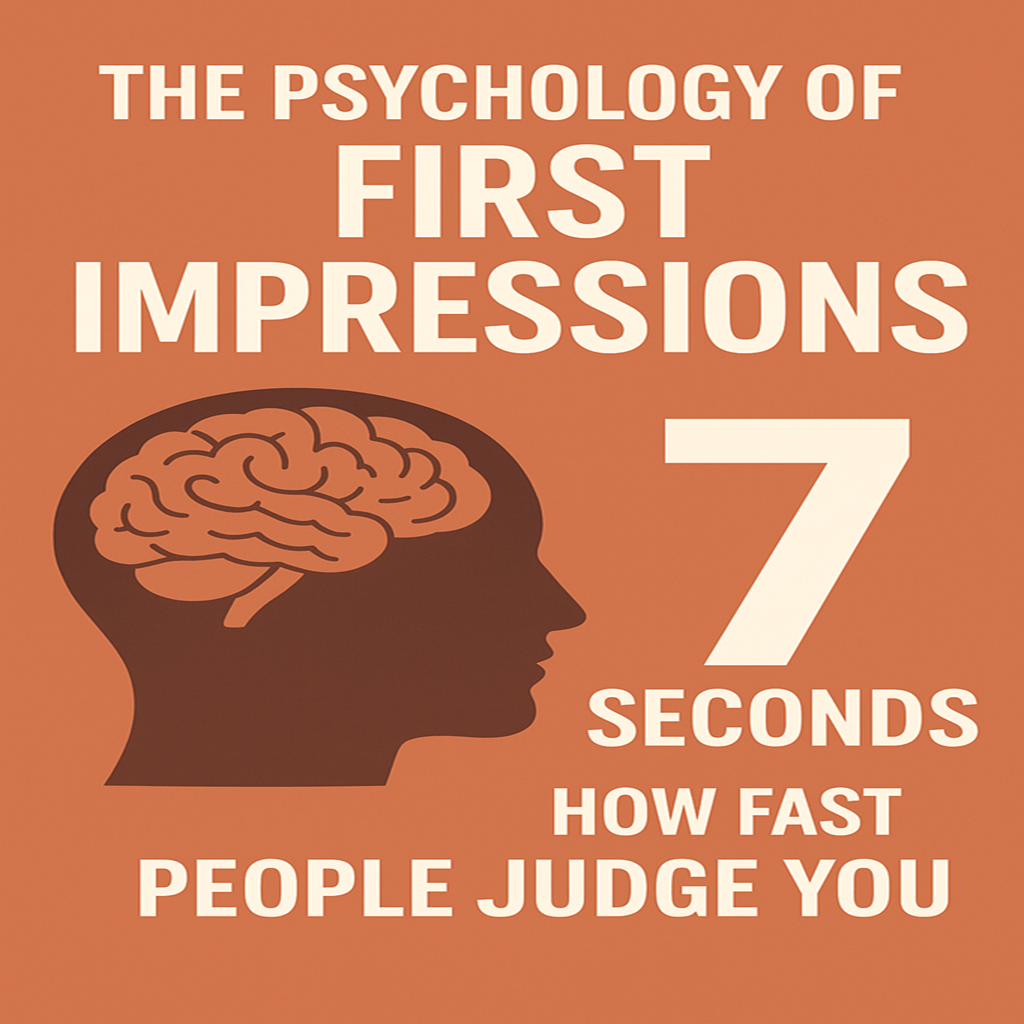
The Psychology of First Impressions: How Fast People Judge You
They say, “You never get a second chance to make a first impression.” But what does this really mean in psychological terms? Every day, we encounter strangers—on the street, in meetings, on social media, or during job interviews. Before a single word is spoken, judgments are formed. Sometimes, in as little as a tenth of a second, people decide whether they like us, trust us, or even respect us.
This phenomenon is not just social—it’s deeply rooted in evolutionary psychology, neuroscience, and human behavior. Our brains are wired to make quick assessments as a survival mechanism. But in today’s world, where networking, interviews, and relationships hinge on perception, these snap judgments carry lasting consequences.
In this article, we’ll explore the psychology, neuroscience, and real-world impact of first impressions, and how you can shape them in your favor.
1. The Psychology of First Impressions
A first impression is the initial perception someone forms about you during a short interaction. Psychologists describe it as a combination of appearance, body language, tone of voice, and micro-behaviors.
- Duration of judgment:Research by Princeton psychologists Janine Willis and Alexander Todorov (2006) revealed that people form impressions of others’ attractiveness, trustworthiness, and competence in less than 100 milliseconds.
- Halo Effect:Once the brain decides something positive (e.g., “This person looks confident”), it tends to generalize other traits (e.g., “They must also be intelligent and kind”). This bias works both ways, making first impressions extremely powerful.
First impressions are not objective; they’re emotional shortcutsthe brain uses to reduce uncertainty.
Learn more about Trading psychology and how can Billionaires Success Secrets makes you expert in trading.
2. The Neuroscience of Snap Judgments
Why does the brain judge so quickly?
- Amygdala activation: This small almond-shaped structure in the brain is responsible for fear, trust, and emotional evaluation. When we meet someone new, the amygdala rapidly processes facial expressions to detect threats or friendliness.
- Prefrontal cortex: After the amygdala reacts, the prefrontal cortex evaluates logic and reasoning, but by then, the impression may already be “locked in.”
- Evolutionary function: In ancient times, quick judgments helped humans decide if a stranger was an ally or an enemy. This instinct still lingers today—even though we’re evaluating coworkers, not cavemen.
Neuroscience shows:Your brain makes a decision about someone before you consciously think about it.
3. What Do People Judge First?
When meeting someone new, the brain prioritizes certain traits:
- 1. Trustworthiness – “Can I trust this person?”
- 2. Competence – “Are they capable or knowledgeable?”
- 3. Likeability – “Would I enjoy being around them?”
- 4. Dominance – “Are they confident or intimidating?”
According to Harvard social psychologist Amy Cuddy, people primarily evaluate warmth (trust) and competence. These two traits decide whether someone becomes a friend, foe, or potential leader.
4. The Role of Physical Appearance
Appearance has an undeniable influence on first impressions:
- Facial symmetry: Symmetrical faces are subconsciously judged as more attractive and healthier.
- Clothing: Studies show that well-dressed individuals are perceived as more competent and confident.
- Posture: Standing tall with open body language conveys authority and approachability.
- Eye contact:Too little suggests insecurity; too much can feel aggressive. A balance creates trust.
Interestingly, even something as small as a smile and activates positive responses in the brain. People who smile are seen as more approachable and trustworthy.
5. Body Language and Non-Verbal Cues
Words matter less than we think during first encounters. According to psychologist Albert Mehrabian:
- 55% of first impressions are based on body language,
- 38% on tone of voice,
- only 7% on actual words spoken.
Key non-verbal cues that influence impressions:
- Handshake: Firm (not crushing) conveys confidence. Weak handshakes are often linked to insecurity.
- Gestures:
- only 7% on actual words spoken. Calm movements suggest self-control; fidgeting signals nervousness.
Lesson: How you carry yourself often speaks louder than what you say.
6. The Digital Age of First Impressions
In today’s world, first impressions often happen online before they do in person:
- Social media profiles: People form opinions from profile pictures, captions, and followers.
- Emails and messages: Tone, grammar, and structure shape perceptions of professionalism.
- Video calls: Lighting, background, and eye contact affect how trustworthy or competent you appear.
Studies show recruiters decide on a candidate’s suitability within 7 seconds of viewing a LinkedIn profile.
7. First Impressions in Different Contexts
a) Job Interviews
Recruiters often make subconscious decisions within the first 90 seconds. Dress, posture, and greeting matter more than rehearsed answers.
b) Dating & Relationships
Attraction is often instant. Traits like grooming, confidence, and eye contact can decide whether someone wants a second date.
c) Business & Networking
Entrepreneurs pitching ideas rely heavily on charisma and first impressions—sometimes more than the actual product.
c) Business & Networking
Entrepreneurs pitching ideas rely heavily on charisma and first impressions—sometimes more than the actual product.
d) Social Situations
From meeting in-laws to joining a new club, first impressions determine acceptance into groups.
8. Can You Fix a Bad First Impression?
Yes—but it’s difficult. Research shows that once a negative impression is formed, it takes 6–8 positive encounters to reverse it.
Tips to recover:
- 1. Acknowledge mistakes (authentic humility builds trust).
- 2. Consistency matters show reliability over time.
- 3. Positive body language in follow-up interactions.
While repair is possible, prevention is easier: prepare before important encounters.
9. Cultural Differences in First Impressions
Not all cultures value the same first-impression cues:
- Western cultures (USA/Europe): Direct eye contact and firm handshakes are respected.
- Asian cultures: Excessive eye contact may be seen as disrespectful; humility is valued over dominance.
- Middle Eastern cultures: Warmth and hospitality during first meetings play a crucial role.
Understanding cultural norms ensures you don’t accidentally create the wrong impression.
10. Practical Tips for Making a Strong First Impression
- Dress appropriately: Align with the situation (interview, casual meeting, formal event).
- Mind your body language: Stand tall, make eye contact, and smile genuinely.
- Listen actively: People feel valued when truly heard.
- Speak clearly: Tone and pace influence how others perceive intelligence and confidence.
- Be punctual: Arriving on time shows respect and reliability.
- Show warmth first, competence second: As Amy Cuddy’s research suggests, people connect emotionally before rationally.
11. The Long-Term Impact of First Impressions
Why do first impressions matter so much?
- Anchoring effect: The first impression acts as an “anchor” that influences all future perceptions of a person.
- Self-fulfilling prophecy: If someone perceives you as confident, they treat you that way, which reinforces the behavior.
- Career & relationships: From promotions to marriages, many opportunities depend on initial judgments.
12. Common Myths About First Impressions
- Myth 1: “People don’t notice small details.”
- Myth 2: “You can talk your way out of a bad impression.”
- Myth 3: “First impressions are permanent.”
Truth: Micro-expressions, grooming, and posture matter more than words.
Truth: Non-verbal cues dominate spoken words.
Truth: Hard to change, but not impossible with consistent effort.
Conclusion:
First impressions are not just superficial—they are a scientific blend of psychology, neuroscience, and evolutionary behavior . Within seconds, others judge your trustworthiness, competence, and likeability, often before you speak a single word.
In today’s hyper-connected world, first impressions extend beyond face-to-face encounters into digital profiles, video calls, and emails. Whether in personal relationships, professional networking, or casual interactions, these impressions carry long-lasting effects.
The good news? With awareness, preparation, and authenticity, you can take control of the narrative . Dress with intention, master confident body language, listen actively, and show warmth. Remember—people may judge fast, but you have the power to guide what they see.
In the end, the science of first impressions reminds us of a simple truth: Perception shapes reality . And if you can master the art of the first impression, you open doors to trust, connection, and endless opportunities.

